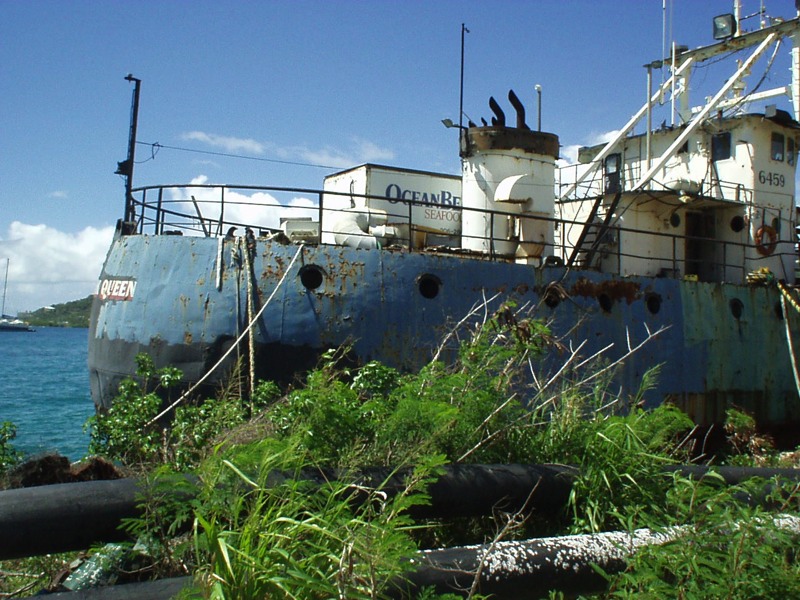
Saving the YO-44
The YO-44 was a US Navy Fuel Barge, launched in September of 1940. She was like thousands of other anonymous Navy vessels which served in peace and in war, performing the everyday mundane tasks to keep a fleet afloat. But the humble YO-44 was there on one important day, in a battle which changed the course of American history: the YO-44 was in the attack on Pearl Harbor, and the YO-44 lived to tell the tale. According to one web account the YO-44 is one of 5 surviving ships which were at Pearl Harbor.
In September 2012 I was sailing off Roadtown, Tortola, BVI and saw a collection of wrecked ships and ferries in a junk yard. I took my boat over for a closer look and made some photographs of these rusting hulks. (see below) When I returned home and looked at my photos I saw the name Kodiak Queen on one of the ships I had photographed. A quick Google search informed me that the Kodiak Queen, was the former YO-44, which had fallen on hard times. It had been deaccessioned from the Navy, converted to a fishing trawler, and after several name changes and a rough 60 years ended up in Roadtown, Tortola
As a historian I could see the importance of this old ship, for if it is true that it is one of 5 surviving ships of the attack on Pearl Harbor it has an important place in American history.
I sent out several emails to institutions, organizations and individuals who I thought might see the significance of this ship. I decided to make this small webpage to serve as a resource page for information about the YO-44.
I have been searching for more information about the history of the YO-44 and found several survivors accounts, and some Navy War Diaries reporting the whereabouts of the YO-44 at various times during the war. I'll post what I find.
It takes some optimism to think that a ship like the Kodiak Queen could be saved and perhaps restored to a place of honor. It would be a shame to know about its history and just let is slide away and turned into scrap metal.
It could be too far gone to save… but it served us once, so maybe, with some optimism, we can return the favor.
If you have information about the YO-44, or want to help, contact me (see link below).
Mike Cochran
Denton, Texas
940-231-5904

Kodiak Queen. Roadtown, Tortola, BVI.
This is supposedly one of 5 ships to survive the attack at Pearl Harbor. What a sad ending for a ship with such history.
YO-44 Fuel Barge (Self-propelled):
Laid down, 1 April 1940, at Navy Yard Mare Island, Vallejo, CA.
Launched, 17 September 1940
Commissioned USS YO-44, 3 January 1941
Allocated to the 14th Naval District
During World War II USS YO-44 was assigned to the Asiatic-Pacific Theater and was at Pearl Harbor, 7 December 1941
Struck from the Naval Register, date unknown
Converted to a fishing trawler for commercial service
Named Vardsha in 1961, registry unknown
Renamed Kodiak Queen in 1967, registry unknown
Renamed Global Queen in 2007, Panama registry
Renamed Kodiak Queen in 2010, registry unknown
Final Disposition, laid up and possibly abandoned at St. Johns BWI, circa 2010
USS YO-44 earned one battle star for World War II service
Specifications:
Displacement 1015 t.(fl)
Length 154' 8"
Beam 29'
Draft unknown
Cargo Capacity
Oil 3,936 Bbls
Speed unknown
Complement unknown
Armament none
Propulsion
three Diesel engines, direct drive
single propeller, 400shp

Bob Farnham, of Bremerton, Wa. was a sailor on the YO-44 on December 7, 1941. Over the years several newspaper articles were written about his experience in the attack on Pearl Harbor.

Small details of that day stick in mind of survivor
PRITCH, Sun Staff
Thursday, December 5, 1991
PULLOUT (NOT DIRECT QUOTE): When Farnham last saw the chief, he was running down the pier with each leg in a different pair of pants, trailing two empty pant legs.
By Lloyd Pritchett
A chief petty officer dashes down a pier with each leg in a different pair of pants. White doves stagger across the grass, too exhausted to fly. A truck drives off, exposing a terrified sailor who'd been hiding under it.
These are some of the strange images that remain chiseled in Bob Farnham's memory from that traumatic day 50 years ago when Japanese warplanes blasted Pearl Harbor.
True, he remembers all the horrific scenes captured on film for posterity -- smoke belching from the battleship USS Arizona, the warplanes dropping bombs, the explosions.
But it's how the bizarre details interweave with the dramatic scenes that define the experience for Farnham.
Now president of the Pearl Harbor Survivors Association's Olympic Peninsula chapter and a Sunnyslope resident, Farnham was one of 12 crewmen stationed on a small fuel tanker, the YO-44, when all hell broke loose on Dec. 7, 1941.
Loaded with 100,000 gallons of highly flammable aviation fuel, with no way to defend itself, the mini-tanker was destined to be the vessel that nobody wanted to be near that day, including the crew itself.
"The skipper said, 'Let's get the hell off of here. This is no place to be,' " remembers Farnham.
But shortly after the crew's departure, the commander of a submarine moored alongside shouted at them to get back aboard and move the tanker away, so it wouldn't blow up everything around it if hit.
The men returned to the tanker, untied it and began heading down the channel toward Mary's Point liberty landing, where there were no other ships.
"It wouldn't have been so bad if you'd had anything to defend youself with," says Farnham. "But without it, you were sitting on a time bomb."
Once out in the channel, the young sailor watched in awe and fear as Japanese planes flew overhead, dropping bombs and torpedoes. But none hit them.
After they reached the liberty landing, the attack subsided and the small tanker's crew launched a pair of boats to go search for survivors. About 30 were found, glistening with thick oil that coated the water.
It was about then, Farnham remembers, that a chief petty officer on the pier decided to take advantage of the lull in the bombing to change from his clean white uniform into dungarees.
He removed one pant leg of his whites and pulled on one leg of his dungarees. Just as he was about to pull off the other white pant leg, another wave of Japanese planes roared in.
When Farnham last saw the chief, he was running down the pier with each leg in a different pair of pants, trailing two empty pant legs.
Meanwhile, Farnham raced up the dock toward a hill.
After taking cover on the hillside, Farnham noticed the doves on the golf course, so exhausted from flying into the air after each explosion that they could no longer get airborne.
"That's when I realized I wasn't the only one scared," he says.
Down below, Farnham could see a panel truck roar up in front of a new post office under construction.
As the driver ran into the building, a sailor dove under the truck for cover. Soon after, the driver ran back out, jumped in the truck and roared off, leaving the sailor exposed out in the street.
"He took off running on his hands and knees," says Farnham.
As the day progressed, the YO-44 was ordered to move twice more.
"They wanted us as far from anything as they could get us," says Farnham.
But when the attack ended, the floating time bomb was still undamaged and Farnham lived to tell about it.
After the war, Farnham settled down in Oregon. But tragedy struck when his mobile home caught fire, killing his first wife.
"Being at Pearl Harbor prepared me for a lot of bad things I've run into since," he says. "It enabled me to handle the (death of his wife)."
He remarried in 1947, moved to Kitsap County and brought up two daughters and a son with his second wife, Verda. They now have eight grandchildren and one greatgrandson.
Farnham retired from Puget Sound Naval Shipyard in 1973 but remains extremely active, serving as a fire commissioner, working at the county landfill, volunteering and speaking.
It was in 1961 that Farnham formed the first chapter of the Pearl Harbor Survivors Association in Washington state. Since then, he has served four times as chapter president and once as the association's national secretary.
The group's primary goal is to prevent America's military forces from ever again being taken by such complete surprise as they were on Dec. 7, 1941. But Farnham has little hope.
"There's no doubt in my mind that apathy will sink in ... and we will get caught with our drawers at half mast once again," he says.
***

© 2012 Scripps Newspaper Group — Online
From the Kitsap Sun, Bremerton, Wa.
DAY OF INFAMY
Linked by History
On Sunday, Dec. 7, 1941, the Japanese attacked Pearl Harbor and brought the United States into World War II.
Today, on another Sunday, Dec. 7 -- 62 years after the attack -- The Sun presents the stories of three of our area's nearly 40 Pearl Harbor survivors.
Chris Barron
Sun Staff
December 7, 2003
• Though they didn't know each other at the time, Bob Farnham and Jim Abrahamson stood yards apart at Pearl Harbor. Later, they served and worked together at PSNS. Now they are neighbors in Sunnyslope.
•••
As bombs blasted mighty battleships and torpedoes tore apart hulls, machine guns rattled from the sky and ground.
Amid the madness of the Japanese sneak attack on Pearl Harbor, hundreds of mourning doves frantically scattered, searching for safety from the deafening noise.
When the chaos ended two hours later, the symbols of peace finally landed.
"They were walking with their little wings down and their beaks open," said South Kitsap resident Bob Farnham, assigned to the Pearl Harbor-based fuel tanker USN YO-44
"They were exhausted. They weren't the only ones."
The day was Dec. 7, 1941, a sleepy Sunday morning similar to the one today. Most sailors and soldiers were either in their bunks or had just gotten up on the non-work day.
And even when the bombs began dropping, it was hard to believe an attack was happening.
"There were a bunch of planes flailing around, both close to the surface and above the ground in a mad tangle," said Jim Abrahamson, a South Kitsap resident assigned to the submarine base. "I thought they were playing around.
"I didn't see the (Japanese) insignia quick enough. But it didn't take long. Somebody straightened me out."
50 yards apart
Nearly 5,000 of the more than 35,000 sailors and soldiers stationed at Pearl Harbor in 1941 are still living.
Two of the survivors, the 80-year-old Farnham and 83-year-old Abrahamson, have lived a short walk away from each other in Sunnyslope for more than 50 years. They stood about the same distance apart watching the Japanese planes attack Pearl Harbor 62 years ago.
The two former Navy cooks, who appropriately reside on Victory Drive, didn't know each other then. They didn't meet until a few years later when they were stationed at Puget Sound Navy Yard in Bremerton.
As civilians, the duo later worked for 30 years at the shipyard as their lives continued similar paths.
Even more eerie, Farnham and Abrahamson, who worked in the shipyard's personnel office together in their final months in the Navy, were discharged from the service on the same day -- Thanksgiving 1945.
Abrahamson, a classic sailor type with large World War II-era tattoos dominating his arms -- "I hate naked arms," he said -- doesn't dwell on the past. He's matter of fact about his Pearl Harbor experience.
"You have to be," he said. "You learn real quick you're either going to be alive or dead."
Abrahamson is not a member of the local Pearl Harbor Survivors Association chapter and does not attend the annual remembrances. "I got all the memories I'm going to get out of it," the witty former sailor said.
Farnham, however, is an active Pearl Harbor survivor, studying the subject endlessly. He once served as national treasurer for the association and helps organize local chapter events.
He said the continued fascination with the attacks on Pearl Harbor and those who were there is simple to explain.
"It has the unique background of mystery," he said. "Were we sold down the river or weren't we? Also, it pulled the country together like never before."
The Japanese attack
Shortly before the attacks 62 years ago today, Farnham had just awakened and was about to prepare breakfast for his 11 shipmates on the fuel tanker. In the bathroom, he looked out the porthole as he heard planes flying low near his ship.
"A torpedo plane went by our stern and I could see a great big red ball on the side of it," he said. "I jumped back and said, 'The Japs are here, and they're not kidding!' "
Abrahamson, having partied a bit the night before, was sleeping as the Japanese attacked.
"Someone came running in and said, 'Hey, they're bombing!'" he recalled. "I said, 'Come on.' But they were."
Assigned to the submarine base, Abrahamson didn't have a battle station. He eventually grabbed a rifle, but mainly just watched the Japanese bomb and torpedo for the next two hours.
"What else are you going to do?" he said. "You're 21 years old. You're not going to run because you're not scared. I wasn't bright enough to be scared.
"I'd never been shot at it, except maybe by a father or two."
In the first 10 minutes, Farnham said he stood in disbelief and watched the attack. His shipmates hurriedly left their floating firetrap, which held 100,000 gallons of aviation fuel.
If a bomb hit his fuel tanker, Farnham said, the submarines and the base might have been taken out.
"At first, I was too awestruck to be afraid," he said. "It really hit when the (battleship USS) Arizona blew. I was looking right at it. I saw these little white specks coming out of that massive flame and to this day I swear it was white uniforms.
"That's when reality set in. That's when I got scared."
Six decades later
The two Sunnyslope neighbors rarely discuss the happenings at Pearl Harbor with each other. Both contend the incident, while an important chapter in their lives, didn't change them.
"It certainly didn't change my opinion of the people in this country, and it hasn't changed it to this day," Farnham said. "Over a length of time, apathy sets in, but not their regard for their country, their neighbor and for themselves."
Abrahamson, with his sly humor, said the attacks were great because "I went into the Navy to see action," he said.
But discussing or reminiscing about Dec. 7, 1941 doesn't much interest him.
"It's not that I'm afraid or disinterested, but I never did follow things that already happened," he said. "I know what it was like. I was there in the real one."
From The Messenger, Houston and Anderson County, Texas
Navy Veteran Remembers Pearl Harbor Attack
RACHAEL RILEY
Thursday, November 10th, 2011

Bob White entered the Navy as an apprentice seaman and left with a captain note in his records.
When Sweetwater, Texas, native Bob White joined the Navy July 15, 1940, little did he know he would witness an infamous enemy attack on Dec. 7, 1941.
At the energetic age of 20, he decided to enlist with a friend whose name was also White; but his friend’s parents wouldn’t let him join until finishing high school.
“I met him over in Pearl Harbor a couple of times after that,” White said. “He had signed up since he graduated.”
White trained in San Diego, Calif., as an apprentice seaman for eight weeks and soon earned the Second Seaman rank. He then transferred to the USS Argonne - a repaired sinker ship - for nine months. His next transfer was aboard the USS YO-44, which was one of two oil and gas tankers delivering aviation gas and diesel fuel to ships in the harbor. During the morning of Dec. 7, 1941, the YO-44 was tied alongside a submarine. White saw the first of the Japanese bombers who sunk the USS Arizona.
“They looked like they were going to get us, but they got about halfway down- it looked like they angled-and it missed us about a half a mile” he said. “I didn’t know it was the Arizona that went down.”
As the other ships in battleship row were torpedoed, White admitted he was scared because he didn’t have a gun. At the time, the crew didn’t even have nails in shoes for fear sparks would ignite the ship’s 60,000 gallons of cargo fuel and 150,000 gallons of aviation gas.
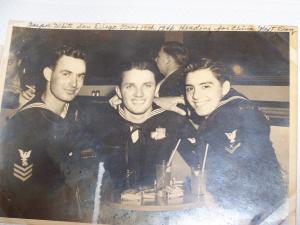
As the West Virginia sunk and the Oklahoma capsized, White remembers crews wanted the YO-44 out of the way to prevent any more explosions. After the first wave of Japanese attacks, White and his shipmates pulled the ship’s CO2 valves and abandoned the ship at the fleet landing.
“But we still stayed on dockside right by it,” he said. “And this plane came over us and as soon as it passed us, it started machine gunning this big tanker (the Sabine); but it just looked like a sewing machine was going across it. You can see the bullets hit, but they were bouncing off. But if he started a little earlier, he’d got all of us.”
While White personally didn’t know any of the perished souls, he doesn’t enjoy remembering seeing a hole cut into the bottom of the Oklahoma in order to pull men out a few days later. He cringes at the thought of dead sailors with swollen bodies floating to the top of the water.
Instead, he recalled what a first class boatman, who survived the Oklahoma capsizing, told him when boarding the YO-44.
“They were going up this ladder to see what was going on, and a bomb hit right close to him in the water; and the spray came over and washed him off this ladder,” White said. “And one of the sailors went back up and said, ‘them dirty dogs they’re not satisfied with bombing on us, they’ve got to pee on us too.”

In the following days, White worked day and night de-fueling the ships. He and his comrades couldn’t believe the harbor was filled with crude oil, more than two inches thick on the water’s surface. During one night when docking and taking a valve line, White intended to jump on the dock but missed. Fortunately a Marine who was on guard stopped him and found a piece of ladder to help him climb out. He was covered in oil.
After remaining in Hawaii for six months, White transferred back to California, first staying at a naval receiving station known as Treasure Island for three months. His next assignment was another nine months at a San Diego landing craft school. The day he left for training school in New Guinea-for another 18 months-his wife gave birth to their first son.
“The nurse brought him and he was wrapped up and she took the blanket off his face and held him up and then covered him up and took off,” White said. “That’s all I saw of him, but he was 2 and a half years old when I saw him again.”
He would later have three more sons. After six years of service in the Navy, he promised his wife he would get out. His last day was July 16, 1946. However before leaving, he took the naval exam for the chief position in the Philippines. He found out his name had been submitted wrong on the application, but was transferred back to the U.S. on July 13.
When joking around with fellow first-class officers about positions they could be, one grabbed White to look at his records when he told them he could be captain. A man in the records office verified White’s records indicated he could be a chief with his division officer’s recommendation.
“But chief would have been hard to turn down and walk off and leave it. So I never did mention it to my division officer,” White said. “I was discharged as a first class first mate.”
Later in life, he retired from Armco Steel in the 1980s. White now resides in the Houston County Nursing Home, but remembers returning to Pearl Harbor during a survivors get-together.
He pointed out things have changed from what he remembers. A peninsula which used to have trees on it and separated the harbor is no longer visible.
“But you can still see crude oil bubbling up,” he said. “You know, that was nearly 70 years ago.”
Rachael Riley may be reached via e-mail at Rriley@messenger-news.com
Naval War Records which mention the YO-44.
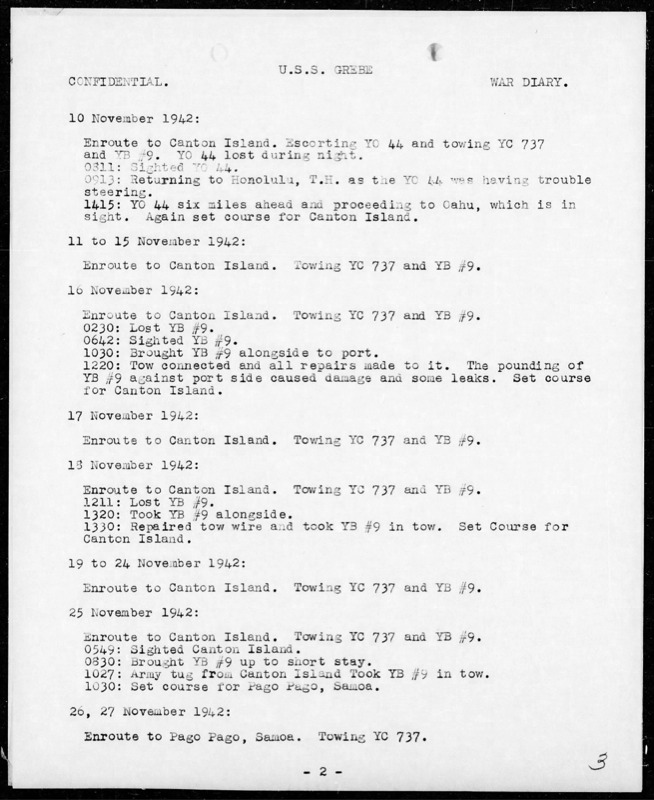
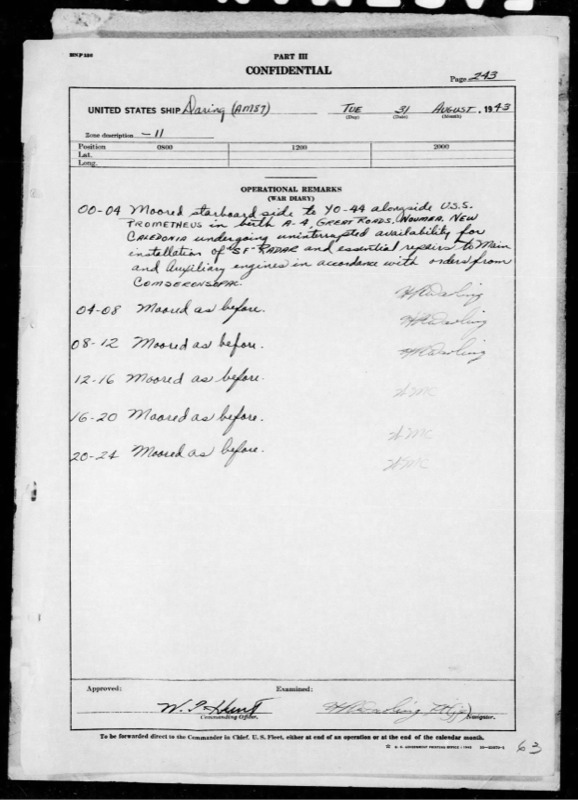
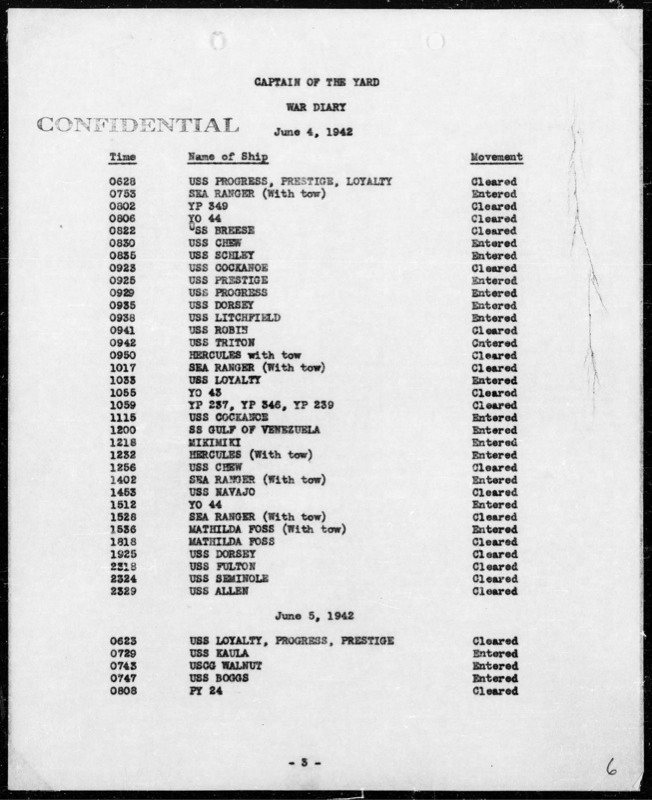
The following two photos are by Mike Cochran.
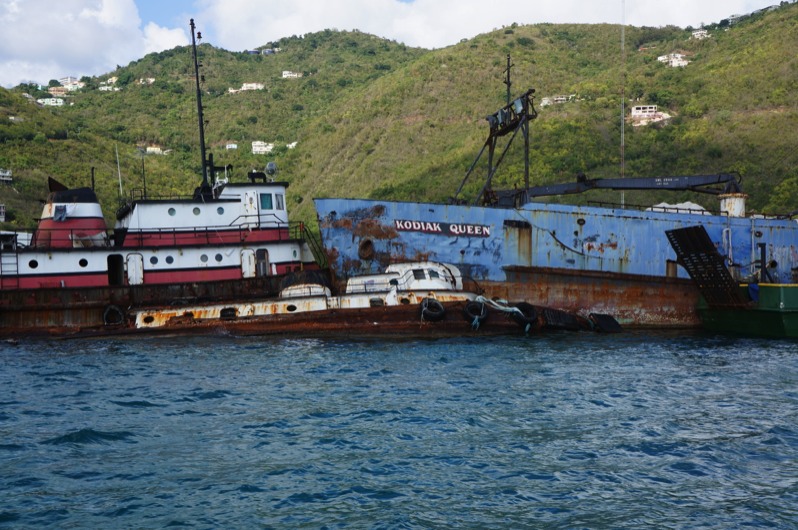
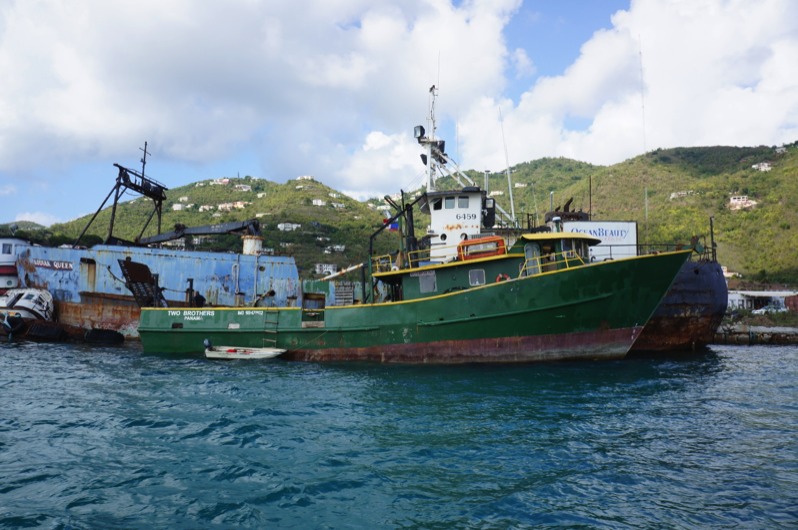
The following two photos are by Jim Woods of Tortola, BVI.
